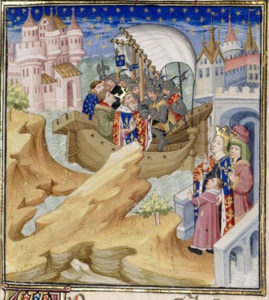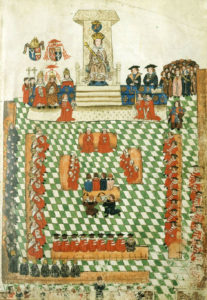
It doesn’t take a huge leap of imagination to connect the two English usurpations of the fourteenth century—both Plantagenets, both accused of letting their favorites unduly influence them, both probably murdered while in prison. (And both of whose murders are debated to this day.) We can be sure the association was very much on Richard II’s mind, especially during the latter half of his reign. But Edward’s fate was most forcibly shoved in his face during the standoff between him and the “Wonderful” Parliament in 1386. This was when the Commons decided to impeach the chancellor, Michael de la Pole—the first official in English history to be removed by impeachment.
Richard was highly indignant that the Commons dare pass judgment on his great officers. He was quoted as saying, “I will not dismiss so much as a scullion from my kitchen at your request!” And he meant it. Taking his friends and household to Eltham, he removed himself from Parliament, making it impossible for them to get any business done without his presence. But this state of affairs could not last long, and the Lords and Commons sent the Duke of Gloucester and Thomas Arundel, Bishop of Ely to persuade the king to return. Richard hated Gloucester, his youngest uncle, who was overbearing, arrogant, and brutal with his criticism. This day proved no exception. Unbeknownst to Richard, before he left Parliament, Gloucester had sent for the archives to see if he could find a precedent from Edward II’s deposition which he might use against his nephew. He found none, but proceeded to fabricate one anyway, to frighten Richard into cooperating. He told Richard, “If ever the king, through evil counsel or wanton ill will, alienates himself from the people—if he does not wish to be ruled by the laws of the land, then it is lawful for them by common consent to remove that king from the royal throne, and substitute another close relative of the royal line in his place.” It worked. Shocked and intimidated, Richard meekly returned to London and permitted Parliament to impeach Michael.

However, Richard was no milksop. He soon learned about Gloucester’s deception and used it against him, precipitating the whole Lords Appellant episode that nearly cost him his throne. Time and again, Gloucester threatened Richard with usurpation like his great-grandfather. The menace never lost its effectiveness. However, the boy king grew up. After he achieved his majority and began reigning in his own name, one of his primary concerns was redeeming Edward II’s reputation and restoring dignity to the crown; it had been badly tarnished by the usurpation and by Edward III’s dotage. What would be the best method to redeem Edward II? Why, nothing less than declaring him a saint. Then nobody could cast aspersions on him again.
Richard sent agents to Pope Urban VI, petitioning him to start the canonization process. Needless to say, the pontiff was lukewarm, but he needed the king’s support so his answer was for Richard to gather evidence of miracles. Edward’s tomb was erected in Gloucester Abbey Church, and soon after his death pilgrims visited the site in great numbers, leaving so many offerings that the church was able to complete St. Andrew’s aisle with their contributions. Richard commissioned a book of miracles performed at Edward II’s tomb and it took five years to complete; by then, there was a new pope and the supposed proof was presented to Boniface IX, who was unimpressed. A second embassy in 1397, headed by Richard Scrope, Bishop of Coventry and Lichfield, fared no better than the first.

It was certainly not unusual to attempt to confer saintly attributes on high-profile medieval “martyrs”. Thomas of Lancaster, Edward II’s arch enemy—whose decapitated body at Pontefract attracted thousands of pilgrims—was serious competition for Edward II. The chronicler Thomas Walsingham even stated in 1390 that he had been canonized (he had not). They couldn’t both be saints! It seemed that popular candidates for sainthood were usually those who rebelled against the crown, and Lancaster fell squarely into that category. After much consideration, Richard concluded that his best chance to beat Thomas Lancaster’s cult was to reverse the judgments of 1326-27 that had vindicated Thomas (and morally condemned Edward II). This reversal would serve two simultaneous purposes: rehabilitate his great-grandfather, and uphold the forfeiture of the Lancastrian inheritance—thereby returning all the estates to the crown. Naturally, this would disinherit all Lancastrian heirs down to Bolingbroke.
Easier said than done! Ultimately, Richards’s grand schemes blew up in his face and his greatest fear came to pass: Bolingbroke came back from exile to reclaim his inheritance and Richard ended up a dethroned prisoner. Apparently, no one aside from the king was interested in Edward II. As historian Chris Given-Wilson said, “With the King’s downfall in 1399, his great-grandfather’s canonization process stopped dead in its tracks, never to be revived.”*
*C.Given-Wilson’s “Richard II, Edward II, and the Lancastrian Inheritance”, The English Historical Review, Vol. 109, No. 432 (Jun., 1994), pp. 553-571